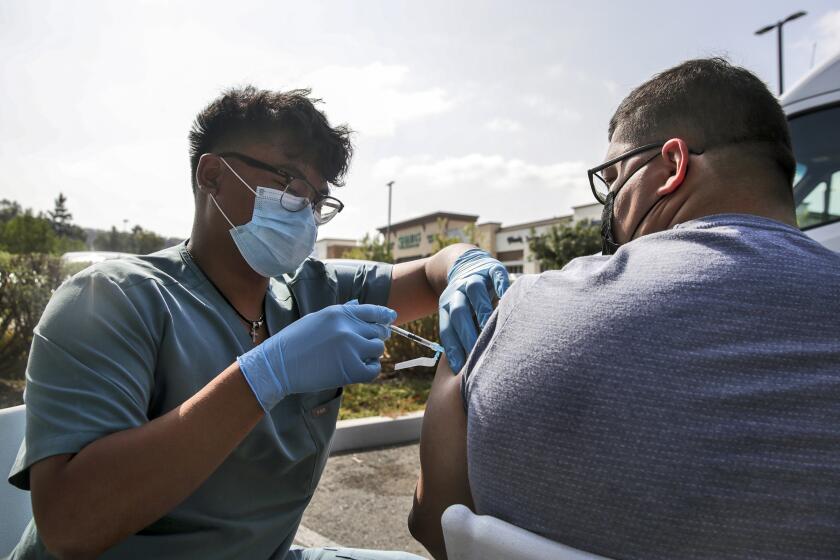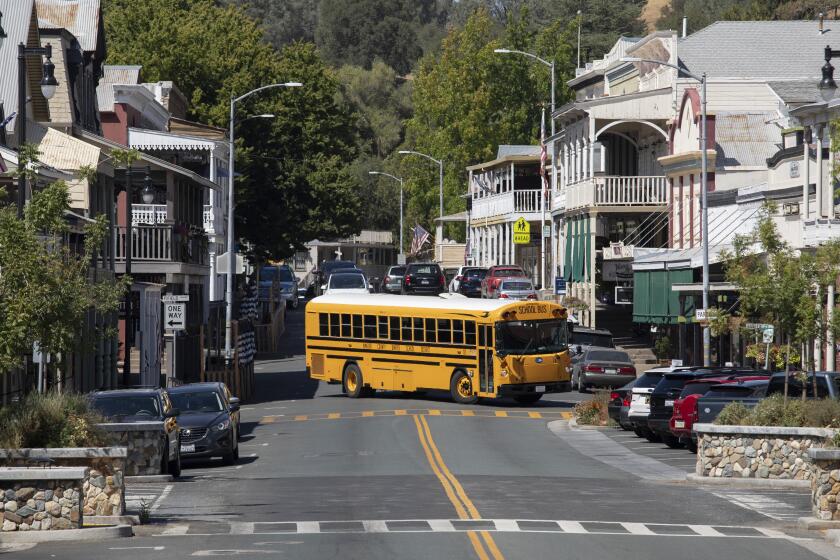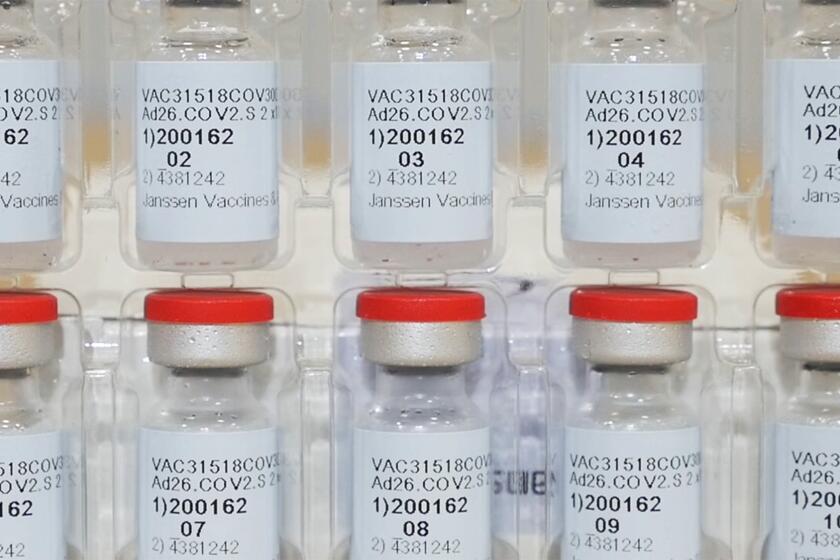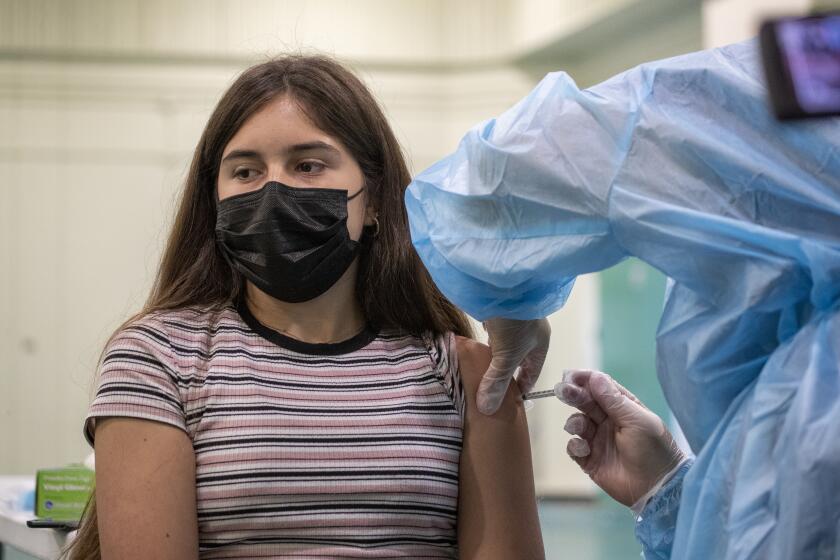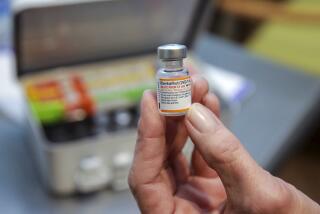California is shaking off the worst of the Delta variant surge

COVID-19 hospitalizations have dropped by half from the summer peak, as California continues to steadily, if slowly, shake off the worst of the Delta surge.
California reached its summer peak in hospitalizations on the last day of August, when 8,353 people with confirmed COVID-19 were in the state’s hospitals. As of Monday, there were 4,467 people hospitalized — a number last seen in early August as the Delta surge picked up steam.
California is now recording half as many new daily COVID-19 hospital admissions as the nation overall on a per capita basis.
Perhaps more promising still is that the wave of COVID-19 patients has started to recede dramatically in areas that were hit hardest during the latest spike.
In Fresno County, where hospitals were at times so overwhelmed that officials feared they would be forced to ration healthcare, the daily census of COVID-19 patients was 284 as of Monday — a decline of 31% from the summer peak a month ago.
Hospitals in Placer County, which stretches from Sacramento’s suburbs to Lake Tahoe, are now caring for 110 COVID-19 patients, half the total seen during the surge’s record-setting heights.
And in tiny Del Norte County, on the northwestern edge of California, where the lone hospital was once so jammed that it had to arrange for helicopters to transport those stricken with COVID-19 elsewhere for treatment, only three coronavirus-positive patients remain, down from a peak of 23 in late August.
Persistent myths about COVID-19 vaccine safety are hobbling efforts to promote the shots in certain parts of California, officials say.
The recent trends are being met with cautious relief in those corners of the state that most acutely felt the pandemic’s latest punch.
“I’m hoping that with the downward trend of COVID patients in the hospital that we’ll start seeing a little bit more relief for the hospitals,” Dan Lynch, director of the Central California Emergency Medical Services Agency, said during a briefing Friday. “But I think, today, the hospitals are breathing a little easier than they were a week ago or two weeks ago.”
But, as has been proven time and again in the COVID-19 era: past is not prologue. Just because conditions are improving now doesn’t mean that progress will continue.
Look no further than the state’s experience last year, when a summertime resurgence of the coronavirus gave way to a prolonged decline in hospitalizations and cases through the early fall.
What followed was the most tortuous phase of the pandemic to date — a viral assault that infected millions of Californians and killed tens of thousands.
“We are very encouraged by the downward trends over the past couple of weeks, but we realize ... this could change as we move into the winter and holiday season if people aren’t careful, and also if we don’t maintain momentum on increasing vaccination rates,” said Dr. Christina Ghaly, Los Angeles County’s director of health services.
Schools have become the battleground in the cultural war over COVID-19.
Unlike some other parts of California, which were hit with unprecedented numbers of new infections and coronavirus-related hospitalizations over the summer, L.A. County saw comparative success in mitigating the worst health outcomes.
During the 2020 summer surge — when vaccines hadn’t yet been authorized for widespread distribution — L.A. County was reporting about 2,800 new coronavirus cases a day at most, and the number of people hospitalized for COVID-19 peaked at around 2,200.
But this past summer, the peak of COVID-19 hospitalizations was notably lower, at more than 1,700, even though L.A. County hit an even higher number of daily coronavirus cases, more than 3,300.
The county also recorded fewer COVID-19 deaths: 44 a day during the peak in the summer of 2020, versus 30 deaths a day this past summer.
“This pattern of more infections, but less severe and fatal illness, is likely due to the highly infectious Delta variant and the ability of vaccines to blunt serious illness and death,” said county Public Health Director Barbara Ferrer. “And while we’re glad for the lower death rates this year, these are largely preventable deaths, and they remain a tragic reminder of this virus’s destructive potential, particularly among those unvaccinated.”
The decline in those hospitalized with COVID-19 follows a similarly large decrease in how many people are being infected in the first place.
Over the last week, California has reported an average of 6,169 new coronavirus cases a day, according to data compiled by The Times. At the height of the summer surge, that rolling case average exceeded 15,000.
But even as transmission continues to fall, officials stress that those who have yet to be inoculated remain vulnerable.
According to recent data from the California Department of Public Health, unvaccinated residents are roughly eight times more likely to get infected with the coronavirus — and almost 18 times more likely to die from COVID-19 — than their fully vaccinated counterparts.
Johnson & Johnson asks U.S. regulators to allow boosters of its COVID-19 shot as the government tries to shore up protection in vaccinated Americans.
Just over 60% of all Californians have already completed their inoculation series. But that still means millions of people have yet to roll up their sleeves, including all children under the age of 12, who aren’t eligible for the shots.
And even in places where overall coverage is high, officials are concerned that less-vaccinated communities remain at risk of future outbreaks.
In L.A. County, where about 61% of all residents are already fully vaccinated, “we have pockets where transmission is still of significant concern, and those pockets are, as we’ve noted before, they’re in communities where we have the lower vaccination rates,” Ferrer told the L.A. County Board of Supervisors on Tuesday.
Among all L.A. County residents age 65 and older, for instance, 92% have received at least one dose, and 82% are fully vaccinated.
However, it’s adolescents and teenagers who are not only spreading the coronavirus at the highest rates, but also are among the least likely to be vaccinated. Only 66% of those age 12 to 17 have received at least one shot, and 57% are fully vaccinated.
“We do have a way to go before we have enough people vaccinated that the virus — or new variant of the virus — would have trouble gaining traction,” Ferrer said. “So many pockets of unvaccinated individuals are unfortunately breeding grounds for transmission and mutations.”
The mandate would take effect for grades 7 through 12 the semester after the FDA’s full approval of the vaccine for children 12 and older.
California is considered by the U.S. Centers for Disease Control and Prevention to still have a substantial level of coronavirus transmission — the second-worst category in the agency’s calculations. Still, as of Tuesday night, California has the lowest coronavirus transmission rate among the 50 states.
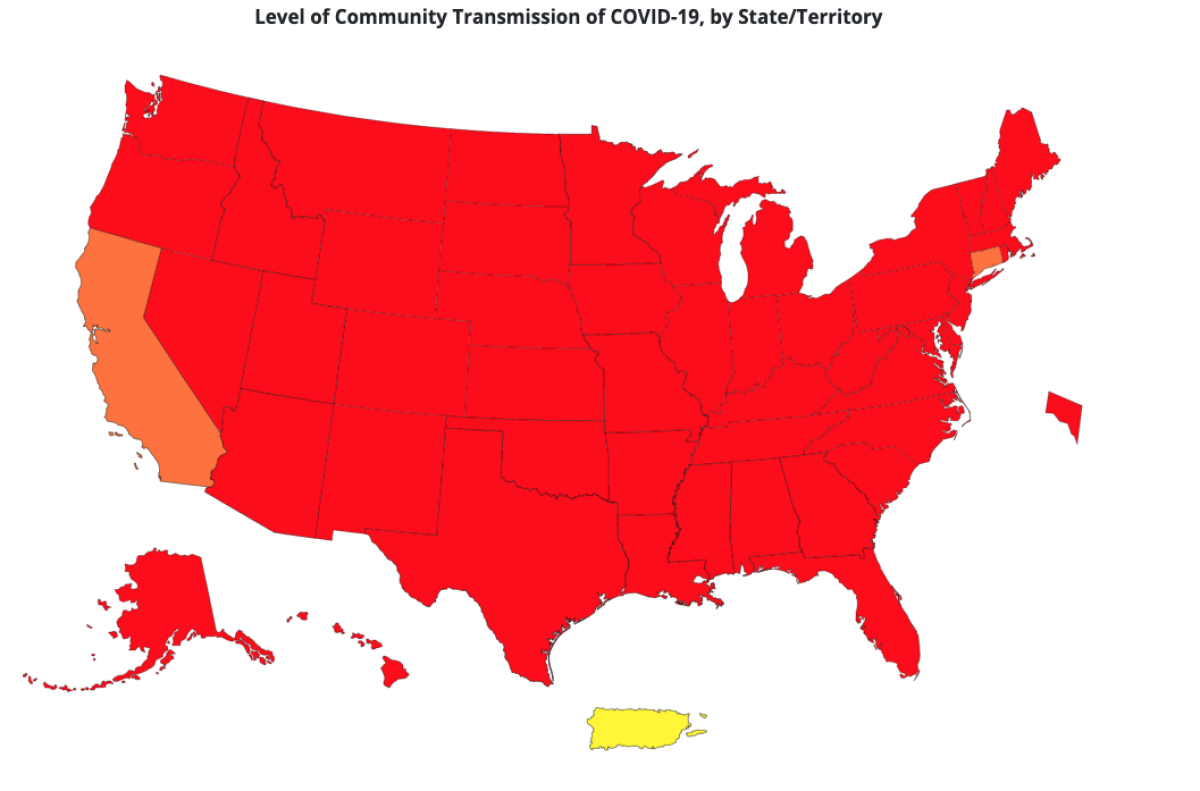
The pressure on California’s hospitals still varies widely by region. For every 100,000 residents, the San Joaquin Valley has 27 COVID-19 patients in hospitals; in rural Northern California; it’s 25; and the Greater Sacramento region, 18. Riverside and San Bernardino counties have a rate of 13; San Diego County, 10; Ventura County, 8; and Los Angeles and Orange counties, 7.
The San Francisco Bay Area has a rate of 6. Some experts think it’s reasonable to lift indoor mask mandates once there are fewer than 5 COVID-19 patients hospitalized for every 100,000 residents.
The CDC suggests that people continue to wear masks in indoor public settings in counties where coronavirus transmission levels are either substantial or high, the worst two categories in the agency’s four-tier scale. As of Tuesday night, every California county reporting data to the CDC was still in those two worst categories, colored orange or red on the agency’s map.
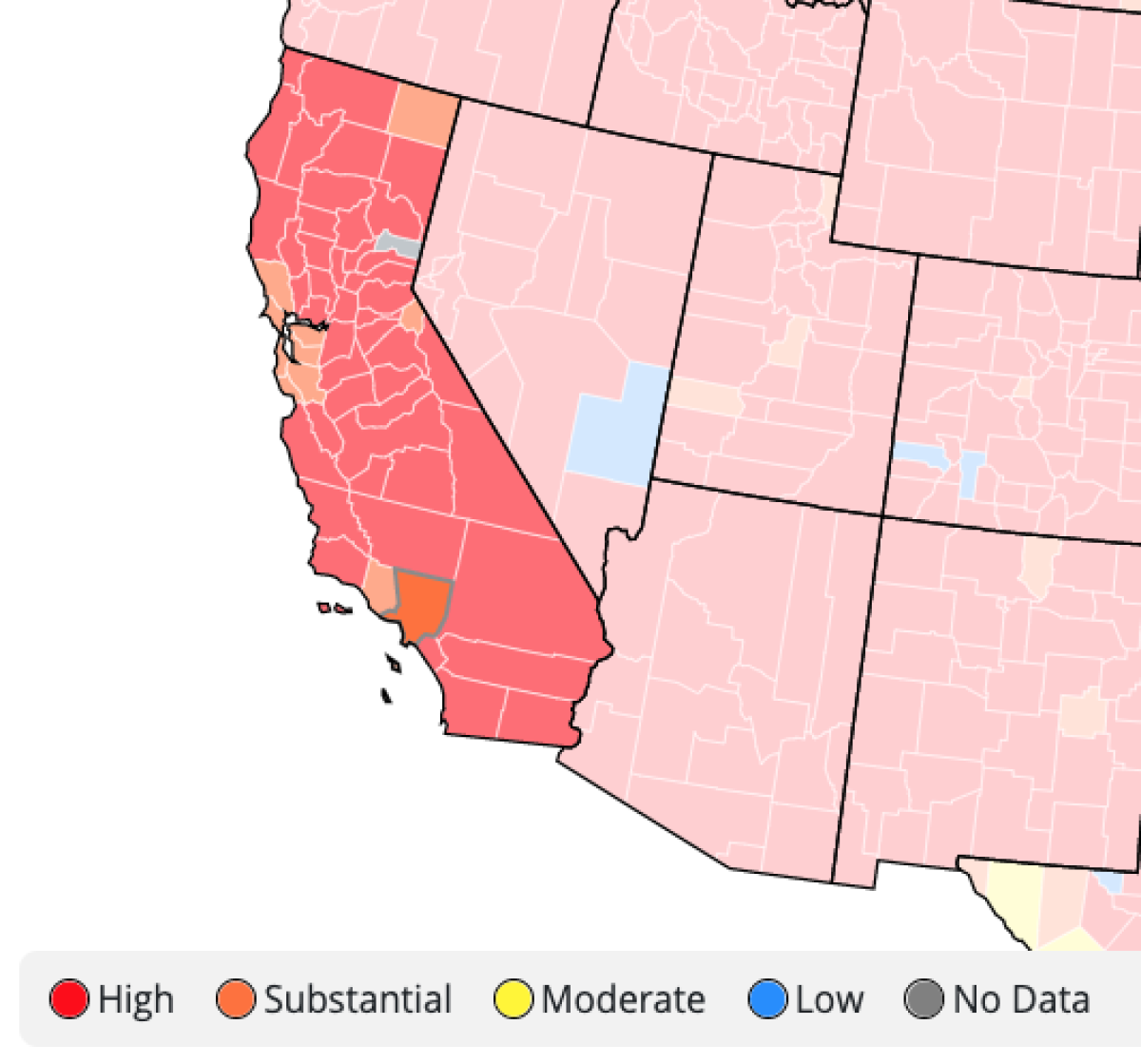
Ferrer said she’s hopeful that with continued declines in coronavirus cases, residents can plan for parties, gatherings and travel during the holidays.
People are considered fully vaccinated two weeks after getting one dose of the Johnson & Johnson shot — offering people time to be considered protected in time for Halloween.
Those who get their first of two required Pfizer-BioNTech or Moderna doses this week, and get their second dose on time, would be fully protected before Thanksgiving.
“While we continue to live with the uncertainties posed by a mutating virus, one thing is uncertain: whatever your plans, they will be safer if you and your loved ones are vaccinated,” Ferrer said.
It’s still too early to lift the mandatory mask order for all indoor public settings in Los Angeles County, Ferrer said. Easing of mask rules will come when vaccination rates rise and viral transmission rates drop, she said.
“The only way that we end the pandemic is if we get unvaccinated people vaccinated, and that is the highest priority,” Ferrer said. “We have to continue to work with people on how important it is to overcome the hesitancy at this point, get vaccinated, particularly to avoid ... another deadly winter surge.”
Cumulatively, more than 69,000 Californians infected with the coronavirus have died since the pandemic began more than 19 months ago. More than 6,000 deaths have been reported since summer began.
More to Read
Start your day right
Sign up for Essential California for news, features and recommendations from the L.A. Times and beyond in your inbox six days a week.
You may occasionally receive promotional content from the Los Angeles Times.
